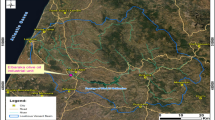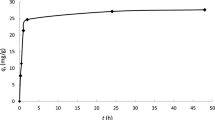Abstract
The current study focuses on investigating how to improve the efficacy of the combined process of aerated lagooning and adsorption for the treatment of olive mill wastewater (OMWW) from the olive industries in the Loukkos region using the design of experiments approach. The latter made it possible to optimize the experimental conditions, such as the mass concentration of lime, the mass concentration of powdered activated carbon (AC), and the speed of agitation (Va), which are required for the envisaged treatment, in order to control the results after the evaluation of the necessary physicochemical parameters, namely pH, total suspended solids (TSS), chemical oxygen demand (COD), rate of discoloration, and content of polyphenols. The experimental conditions necessary to carry out this study were between 1.4 and 1.75 g/l for AC, between 23 and 32 rpm for the stirring speed, and between 0.88 and 1.3 g/l for the mass concentration of lime. The results of this experiment showed that treating OMWW with the prototype II after adding lime to the mixture resulted in an estimated 85% reduction in the analyzed parameters. The pH, TSS, COD, discoloration rate, and polyphenol content were all reduced from initial values of 4.87, 0.63 (g/l), 80.3 (g (O2/l)), 0.8%, and 1.45 (g/l), respectively, to final values of 6.92, 0.12 (g/l), 12, 0.16%, and 0.25 (g/l). These results are highly significant when compared to those obtained during the treatment of prototype I using only powdered activated carbon, which showed a reduction rate of around 70%.





Similar content being viewed by others
Data availability
The datasets generated during and/or analyzed during the current study are available from the corresponding author on reasonable request.
References
Ait-Hmane, A., Mandi, L., Ouazzani, N., Hammou, H. A., Hejjaj, A., Alahiane, S., & Assabbane, A. (2021). Combined treatment of olive mill wastewater by multi-soil-layering ecotechnology and adsorption on activated carbon/lime. Desalination Water Treat, 233, 253–260.
Al-Hmoud, L. (2020). Olive mill wastewater treatment: A recent review. Jordanian Journal of Engineering and Chemical Industries (Jjeci), 3(3), 91–106. https://doi.org/10.48103/jjeci3112020
Allaoui, M., Berradi, M., Bensalah, J., Es-Sahbany, H., Dagdag, O., & Ibn Ahmed, S. (2021). Study of the adsorption of nickel ions on the sea shells of Mehdia: Kinetic and thermodynamic study and mathematical modelling of experimental data. Materials Today: Proceedings, 45, 7494–7500. https://doi.org/10.1016/J.MATPR.2021.02.234
Azzam, M. O. J., & Hazaimeh, S. A. (2021). Olive mill wastewater treatment and valorization by extraction/concentration of hydroxytyrosol and other natural phenols. Process Safety and Environmental Protection, 148, 495–523.
Bachi, O. E., Halilat, M. T., Bissati, S., Al-Ansari, N., Saggai, S., Kouadri, S., & Najm, H. M. (2022). Wastewater Treatment performance of aerated lagoons, activated sludge and constructed wetlands under an arid Algerian climate. Sustainability (Switzerland), 14(24). https://doi.org/10.3390/su142416503
Bensalah, J., Berradi, M., Habsaoui, A., Allaoui, M., Essebaai, H., El Khattabi, O., Lebkiri, A., & Rifi, E. H. (2021). Kinetic and thermodynamic study of the adsorption of cationic dyes by the cationic artificial resin Amberlite®IRC50. Materials Today: Proceedings, 45, 7468–7472. https://doi.org/10.1016/J.MATPR.2021.02.028
Berradi, M., & El, A. (2016). Review of the pollution of surface water by effluents from the textile finishing industry. Journal of Water Sciences & Environment Technologies, 2016(01), 76–82.
Berradi, M., & El Harfi, A. (2017). Discoloration of charged models wastewater with reactive and dispersed dyes by the combined process of coagulation-ultrafiltration. Journal of Materials and Environmental Science, 8(5), 1762–1769.
Berradi, M., Chabab, Z., Arroub, H., Nounah, H., & El Harfi, A. (2014). Optimization of the coagulation/flocculation process for the treatment of industrial wastewater from the hot dip galvanizing of steel. Journal of Materials and Environmental Science, 5(2), 360–365.
Berradi, M., Berradi, O., Chellouli, M., Hsissou, R., El Bouchti, M., El Gouri, M., Sallek, B., El Bachiri, A., & El Harfi, A. (2020). Optimization of the synthesis of ultrafiltration asymmetric membranes based on organic polymers. Results in Engineering, 6, 100116. https://doi.org/10.1016/J.RINENG.2020.100116
Berradi, M., Essamri, A., & El Harfi, A. (2016). Discoloration of water loaded with vat dyes by the membrane process of ultrafiltration. Journal of Materials and Environmental Science, 7(4), 1098–1106.
Berradi, M., Hamid, T., Kadiri, L., & Ouass, A. (2019). Adsorption of heavy metals (nickel) by the shell powder of the coast of Mehdia-Kenitra (Morocco). Analytical & Bioanalytical Electrochemistry, 11(January), 1547–1558.
Bezerra, M. A., Santelli, R. E., Oliveira, E. P., Villar, L. S., & Escaleira, L. A. (2008). Response surface methodology (RSM) as a tool for optimization in analytical chemistry. Talanta, 76(5), 965–977.
Domenech, E., Amorós, I., Moreno, Y., & Alonso, J. L. (2018). Cryptosporidium and Giardia safety margin increase in leafy green vegetables irrigated with treated wastewater. International Journal of Hygiene and Environmental Health, 221(1), 112–119. https://doi.org/10.1016/J.IJHEH.2017.10.009
Eddaoukhi, A., Berradi, M., El Yacoubi, A., El Mokhtar, M., Berradi, O., Grou, M., Amrani, A., Bouraada, K., Nassali, H., El Bachiri, A., Habsaoui, A., & Rifi, E. H. (2023). Spatiotemporal assessment of the impact of olive-growing industry effluent on the Elmakhazine wadi dam in the Loukkos region (Morocco). Investigations into physicochemical, bacterial, and statistical processes. Materials Today: Proceedings, 72, 3875–3881. https://doi.org/10.1016/J.MATPR.2022.10.123
Elayadi, F., El Adlouni, C., El Herradi, M. A. E., El Krati, M., Tahiri, S., & Naman, M. N. F. (2019). Effects of raw and treated olive mill wastewater (OMW) by coagulation-flocculation, on the germination and the growth of three plant species (wheat, white beans, lettuce). Moroccan Journal of Chemistry, 7(1), 1–7.
Es-sahbany, H., Berradi, M., Belfakir, M., & El Youbi, M. S. (2016). Kinetic study of copper adsorption onto Moroccan Illitic and kaolinite clay. Moroccan Journal of Chemistry, 4, 352–360.
Es-Sahbany, H., Berradi, M., Nkhili, S., Hsissou, R., Allaoui, M., Loutfi, M., Bassir, D., Belfaquir, M., & El Youbi, M. S. (2019). Removal of heavy metals (nickel) contained in wastewater-models by the adsorption technique on natural clay. Materials Today: Proceedings, 13, 866–875. https://doi.org/10.1016/J.MATPR.2019.04.050
Finckh, S., Beckers, L. M., Busch, W., Carmona, E., Dulio, V., Kramer, L., Krauss, M., Posthuma, L., Schulze, T., Slootweg, J., Von der Ohe, P. C., & Brack, W. (2022). A risk based assessment approach for chemical mixtures from wastewater treatment plant effluents. Environment International, 164, 107234. https://doi.org/10.1016/J.ENVINT.2022.107234
Gaga, Y., Benmessaoud, S., Kara, M., Assouguem, A., Al-Ghamdi, A. A., Al-Hemaid, F. M., Elshikh, M. S., Ullah, R., Banach, A., & Bahhou, J. (2022). New margin-based biochar for removing hydrogen sulfide generated during the anaerobic wastewater treatment. Water (Switzerland), 14(20). https://doi.org/10.3390/w14203319
Hmamouchi, S., El Yacoubi, A., Massit, A., Berradi, M., El Hezzat, M., Sallek, B., & Chafik El Idrissi, B. (2023). Photocatalytic decomposition of methylene blue dye using sand-graphite composite under visible light irradiation. Materials Today: Proceedings, 72, 3677–3685. https://doi.org/10.1016/J.MATPR.2022.09.044
Ho, L., & Goethals, P. L. M. (2020). Municipal wastewater treatment with pond technology: Historical review and future outlook. Ecological Engineering, 148, 105791. https://doi.org/10.1016/J.ECOLENG.2020.105791
Jana, D. K., Bhunia, P., Das Adhikary, S., & Bej, B. (2022). Optimization of effluents using artificial neural network and support vector regression in detergent industrial wastewater treatment. Cleaner Chemical Engineering, 3, 100039. https://doi.org/10.1016/J.CLCE.2022.100039
Larson, M. G. (2008). Analysis of variance. Circulation, 117(1), 115–121.
Rissouli, L., Benicha, M., Chafik, T., & Chabbi, M. (2017). Decontamination of water polluted with pesticide using biopolymers: Adsorption of glyphosate by chitin and chitosan. Journal of Materials and Environmental Science, 8(12), 4544–4549. https://doi.org/10.26872/jmes.2017.8.12.479
Sarti, O., El Mansouri, F., Yahia, E. H., Otal, E., Morillo, J., & Saidi, M. (2023). Efficient removal of tannic acid from olive mill wastewater using carbon steel slag. C, 9(1), 32.
Sathya, K., Nagarajan, K., Carlin Geor Malar, G., Rajalakshmi, S., & Raja Lakshmi, P. (2022). A comprehensive review on comparison among effluent treatment methods and modern methods of treatment of industrial wastewater effluent from different sources. Applied Water Science, 12(4), 70.
Xavier, C. R., Mosquera-Corral, A., Becerra, J., Hernández, V., & Vidal, G. (2009). Activated sludge versus aerated lagoon treatment of kraft mill effluents containing β-sitosterol and stigmasterol. Journal of Environmental Science and Health, Part A, 44(4), 327–335. https://doi.org/10.1080/10934520802659646
Acknowledgements
The authors of this study present their sincere thanks to the Editor in Chief for managing this article and also to all anonymous reviewers for their great feedback and edits that have helped us improve the quality of this paper significantly.
Author information
Authors and Affiliations
Contributions
All authors contributed to the conception and design of the present paper. Abdesselam Eddaoukhi: methodology and data collection. Mohamed Berradi: conceptualization, writing the first draft of the manuscript, writing—reviewing and editing. Youssef El Rhayam: software and data collection. Lama Rissouli: methodology and formal analysis. Ahmed El Yacoubi: writing—reviewing and editing. Abdessamad Eddaoukhi: software and figure preparation. Omar Berradi: software and figure preparation. Abderrahim El Bachiri: writing—reviewing, editing, and supervision. Brahim Sallek and Hakima Nassali: supervision and resources. All authors read and approved the final version of the manuscript.
Corresponding authors
Ethics declarations
Conflict of interest
The authors declare no competing interests.
Additional information
Publisher's Note
Springer Nature remains neutral with regard to jurisdictional claims in published maps and institutional affiliations.
Rights and permissions
Springer Nature or its licensor (e.g. a society or other partner) holds exclusive rights to this article under a publishing agreement with the author(s) or other rightsholder(s); author self-archiving of the accepted manuscript version of this article is solely governed by the terms of such publishing agreement and applicable law.
About this article
Cite this article
Eddaoukhi, A., Berradi, M., El Rhayam, Y. et al. Aerated lagoon/adsorption combination method for the treatment of olive mill wastewater: optimizing parameters using study design. Environ Monit Assess 195, 1111 (2023). https://doi.org/10.1007/s10661-023-11726-4
Received:
Accepted:
Published:
DOI: https://doi.org/10.1007/s10661-023-11726-4




